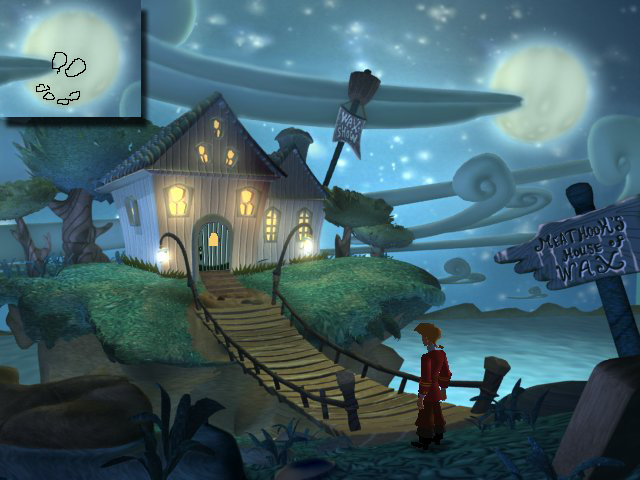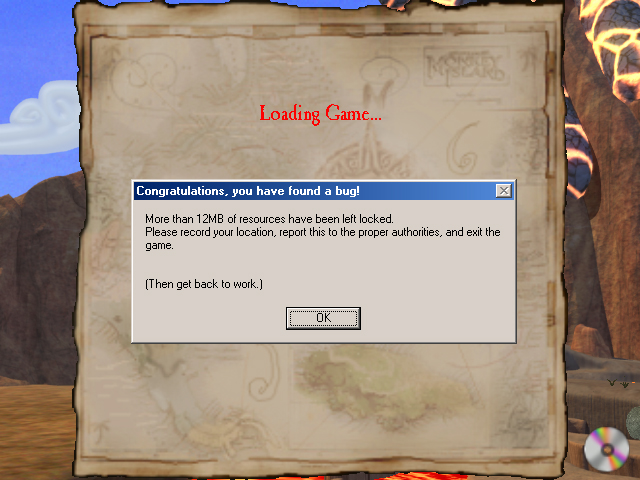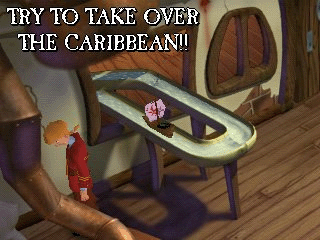Articles

LucasArts' Secret History #14: Escape from Monkey Island Trivia and Resources
Trivia

Bill Tiller, lead artist on The Curse of Monkey Island, had his own idea for a fourth Monkey Island game, which would have explored Guybrush in a situation akin to Mr. Incredible in The Incredibles before being called back into adventure once more. This proposed idea garnered the support of Larry Ahern, Jonathan Ackley, Bill Eaken and Hal Barwood, but Tiller was unable to convince management to let him become involved in a new Monkey Island project due to his responsibilities with Indiana Jones and the Infernal Machine. Ten years later, under his own company, he was able to make his own graphic adventure in the supernatural pirate genre, Ghost Pirates of Vooju Island.
All copies of the original North American printing came packaged with a "quick-path walkthrough," an extremely streamlined but nonetheless complete solution for the game, taken from the much more comprehensive and separately sold strategy guide from Prima.
A rare promotional oddity, bottles of "grog" (in actuality relabeled beer), was available at certain press events. A drink coaster advertising the long defunct www.monkey-around.com also existed at one time.
A blow-up doll of Timmy the monkey was kept in the LEC offices, and has shown up in a number of interesting places, such as in the corner of one of the earliest photographs of the Telltale Games offices – at the time, the company was comprised of four people.
One of the most amusing marketing images for the game was one used to promote the PS2 release in Electronic Gaming Weekly magazine: Guybrush silhouetted against a desert canyon, with the shadow cast being that of a monkey, a nice homage to the Star Wars Episode 1: The Phantom Menace teaser posters.
After the closing credits of the game have completed, Guybrush calls out for the help of a number of people, including characters from the series and eventually even members of the game's development team.
LucasArts' remake of The Secret of Monkey Island added voice work to the game. Since Escape from Monkey Island reprised several of the characters from the first game, it also supplied voice actors for them for the first time. The remake brought back the actors who voiced Carla, Meathook, and Otis in Escape from Monkey Island. LeChuck and the Voodo Lady are voiced by their counterparts in CMI and EMI. In the case of characters who had different voice actors in the third and fourth games (namely, Elaine and Stan), the CMI actors were opted for.
Earl Boen voices LeChuck's alter-ego Charles L. Charles in addition to the infamous ghost pirate himself. When LucasArts went on to develop the aforementioned Special Edition of the first game, Boen similarly voiced his human counterpart Fester Shinetop.
Ignatius Cheese explains to Guybrush that he won the SCUMM Bar from the original owner, "a guy named Ron." Guybrush's incredulous response that Cheese's story sounds like "a humongous fib" could be a reference to the fact that the name of the company Ron founded after leaving LucasArts was Humongous Entertainment.

When Guybrush attempts to enter the kitchen of the SCUMM Bar, he is immediately yelled at to stay out, as he was in the first game.
The provided insults at Guybrush's disposal during Insult Arm Wrestling are a mixture of new insults and insults from the first and third games. Similarly, the Insult Swordfighting with Ozzie that can't be won reprises the insults learned in the previous games.
There are a number of movie parodies/references, the most blatant being a visual homage to 2001: A Space Oddyssey during the cutscene where the monkey tosses the giant Q-tip into the air. Additionally, looking at the iron maiden in the Lucre Hall of Justice will prompt Guybrush to quote Bill and Ted's Excellent Adventure.
Ozzie's brief speech before attempting to activate his Ultimate Insult amplification tower is a slightly modified quotation from the poem "Ozymandias" by Percy Shelley.
When chatting with Ozzie in his mansion, Guybrush can inquire, "Weren't you the one who was supposed to bring balance to the Force?"
The game is littered with references to LEC itself, including hidden logos inside the LUA Bar and Planet Threepwood (which Guybrush makes an explicit reference to when he looks at it). An allusion to the "LucreArts Entertainment Consortium" is also made by the owner of the Bait Shoppe.
When Mr. Cheese explains to Guybrush that Carla lost to Otis in a game of Insult Rock, Paper, Scisssors, Carla complains that "There's no such thing as an 'Illywacker.'" The Illywhacker is a novel by Australian writer Peter Carey, and it's a reference to the fact that the secret to Ozzie's ability to effortlessly win all insult-based competitions is that he uses Australian terminology that none of the pirates are cultured enough to understand.
LucasArts offered a collector's edition of the game to those who pre-ordered through the company store. The edition included a sheet of character magnets and gold-colored signatures of project leaders Mike Stemmle and Sean Clark on the box.
The environment background showing the Mêlée Island docks is only briefly seen in the final game, immediately following the cutscene where Guybrush and Elaine disembark their honeymoon ship. Originally, the location was interactive, as seen in the game's demo, where it served no purpose. Likely, this is the reason the background was removed, although early screenshots from the game depict Guybrush sitting on a barrel in the environment. Also, while the demo features placeholder music from The Curse of Monkey Island, the docks screen in the final game has its own background music, which can unfortunately only be heard for a few seconds, but which exists in its entirety in the game's resource files. The complete track can be downloaded here.
This is the first Monkey Island game to reference Guybrush's middle name: Ulysses.
One of the possible lines Guybrush can say when the lava ride begins is, "I've got a bad feeling about this..."
This game carries on a character trait established for Guybrush by The Curse of Monkey Island: an inexplicable fear of porcelain. Tales of Monkey Island would continue the tradition. Another feature of CMI that subsequent games retrospectively made into a staple is in the form of the distinctive curly clouds.
Despite clearly being a joke, Guybrush and the Voodoo Lady's references to an "unbreakable five game contract" with LucasArts was used by fans as "proof" that a Monkey Island 5 was inevitable. Fortunately for us all, after a nine year dry spell, we did indeed get a fifth game with Tales of Monkey Island.

The outcome of an X-Wing shipwreck can be seen while exploring the Mysts o'Tyme Marshe. In another gag, a sign which reads "Got Time?" modeled after the "Got Milk?" slogan, decorates one of the swamp screens.
This is the only Monkey Island game to call its divisions "Acts" rather than "Chapters" or "Parts."
In the section of the game where Guybrush returns to Mêlée after completing his tasks on Lucre Island, Otis can be found in the harbor by performing the "use" action on the Harbor Mistress's shack, along with a new dialog tree between Guybrush and the Harbor Mistress.
Some fans have cited Jojo Sr.'s name as an error, since Jojo is the name of the piano playing monkey in LeChuck's Revenge. However, since the monkey that Guybrush feeds the five bananas to in the first game is never named, the fact EMI refers to him as Jojo as well doesn't conflict with any known background.
There is a glitch in the game that reveals a key plot point too early. If you have Guybrush look at Herman Toothrot after hitting him with the milk bottle, but before hitting him with the accordion, Guybrush will make reference to Herman really being Grandpa Marley before the revelation has actually been made. Additionally, a dead-end can result by hitting Toothrot with items in a different order than the game expects, forcing the player to reload a prior save to progress in the game.
Although the in-game music is readily available thanks to fan efforts, the cutscene music can't be extracted since it only exists as part of the final mixed audio of the cutscenes, complete with dialog and sound effects. However, after the game's release, Clint Bajakian posted a part of the unreleased score on his web site - the lengthy piece for the game's climactic cutscene (when LeChuck embodies the giant statue of himself). Unfortunately, LucasArts forced Bajakian to take down the track, thus preventing any additional cutscene music from being released, although fans have kept the leaked track in circulation.
The issue of Computer Games Magazine that previewed the game sported a rather striking cover image that is generally held to be superior to the design of the game's actual box art.

After the release of the game, a short-lived "Collector's Edition" package featuring all four games was published exclusively in Australia for a short period (though we have also heard reports of New Zealand and South Africa). Although the contents were simply EMI and CMI in their jewel case versions along with the Monkey Island Madness disc in a paper sleeve, the gigantic box has become a sought after collector's item.
A humorous error message intended for the internal QA team can be found when encountering a bug at the lava field on Monkey Island. The message congratulates the player on their find before ordering them to "get back to work." This error message was removed by the game's patch.
A hidden message apparently left by members of the art team can be found in one of the backgrounds in the SCUMM Bar with some Photoshop tinkering: the repeated message "Randy sucks." This no doubt refers to Randy Breen, a manager at LucasArts at the time who was unpopular with a number of developers.
Guybrush can irritate Murray by performing the "Pick up" action on him, which results in Murray being spun around on the stool he's nailed to. If the player does this enough times that Murray starts to repeat lines of dialog and then types in the letters "murrayball," a Murray-themed version of pong will appear on the screen. After doing so the first time, the player can access Murray Ball anytime afterward in the game by simply typing in "murrayball" again.
In another Murray-related Easter egg, constantly entering the changing tent at the diving area enough times will make the mischievous skull appear.
The "double-tap the arrow key to run" feature originates from Alone in the Dark, which was a major influence on Schafer when he designed Grim Fandango's controls. Despite this, and despite the feature being referenced in both Grim's manual and its readme.txt file, it was cut from the final game.
According to this game, the ending of The Secret of Monkey Island where Guybrush accidentally sinks the Sea Monkey, leaves Monkey Island on Herman's hermit ship and abandons his crew is the one that's canon.
During the cutscene where Guybrush is rummaging through the contents of H.T. Marley's safe deposit chest in the Lucre Island bank vault, some of the items he namechecks include "Grog-O-mints" and "wax lips" – inventory items from The Secret of Monkey Island. In the same scene, he is also seen holding a rubber chicken.
When asked in interviews, Monkey Island alumnus Chuck Jordan claimed to have never played this game, and Ron Gilbert and Dave Grossman both admitted that they'd begun playing only to quit after getting stuck early on.
The SCUMM Bar gets renamed to the LUA Bar after it is converted into a kitschy sushi restaurant. This is a reference to the fact that the SCUMM Bar's namesake is LucasArts' old adventure game engine. In the case of the LUA Bar, LUA is the scripting language for the GrimE engine.
As with all previous Monkey Island games, there is a command to automatically win – Alt +W.
The obligatory reference to Guybrush's signature ability to hold his breath for ten minutes comes when he must locate the underwater entrance to Pegnose Pete's booty showcase.
The Playstation 2 version of the game contains some interesting omissions/additions. For more info check out the preceding section.
In CMI, the menu includes a useless 3D acceleration option that cannot be selected. EMI, a 3D game, continues the gag by including a similarly useless multiplayer option. (No, the subsequent Monkey Island game, Tales of Monkey Island, did not include a multiplayer mode.)
One of the files in Deadeye Dave's file retrieval system belongs to a recipient named "SamNMax." Another file bears the name "Manuel J. Calaverus." Others include: Sean P. Clarkinator, Mikey J. Stemmle, Josephus X. Ackley, and Obi W. Kenobi.
A slightly different version of the game's cover art where Guybrush wears more of a geeky expression on his face could be seen on many online retailers' product pages prior to the game's release before being changed to the final art. The Macintosh port of the game by Aspyr Media, however, used this older iteration of the cover for its final box. Also on the subject of covers, the North American Playstation 2 cover is a completely different design entirely.
If Guybrush listens to all the variations of Deadeye Dave's story and thus collects all the various prosthetics, he can combine them all together into an "abomination of nature," a pointless item that he can use at any point in the game, which causes him to toss it onto the ground while yelling, "It's ALLLIIIIIVVVVEEEE!"
One of the numbers Guybrush can guess when confronted by a duplicate of himself in the marsh is "one one three eight," a reference to the George Lucas film, THX 1138. Later in the game, Reverend Rasputin references 1138 as being the number associated with the Anti-LeChuck.
A man of many talents, Dominic Armato voices the "unspectacular duck" found on Lucre Island.
The chess playing pirates on Lucre Island are loosely modeled after Mike Stemmle and Sean Clark, the game's project leaders.
For the character of Miss Rivers, Mike Stemmle and Sean Clark imagined that the voice should sound similar to that of actress Edie McClerg (best known as Grace from the movie Ferris Bueller's Day Off) and used her name as a reference point for the casting director, never thinking that they'd actually get McClerg herself.
The voice of Hellbeard is Nick Jameson, voice of Max in Sam & Max Hit the Road, Dr. Fred in Day of the Tentacle, and Dr. Loboto in Psychonauts.
Although iMUSE isn't used as integrally as it was in The Curse of Monkey Island, it is still present, with the best example being the switch from major to minor key in the background music when Guybrush rows near Knuttin' Atoll from Jambalaya Island on the overhead map.
The logic behind the game's final puzzle escaped many players, as it is dependent on an observation made when learning Monkey Kombat on Monkey Island: whenever a draw occurs three times consecutively, the opponent will react by instinctively pounding on his head with his fists.
Links/Sources/Resources
- The SCUMM Bar - Still unquestionably the best resource of all things Monkey Island. In addition to being the source for much trivia, it includes many exclusive EMI interviews.
- The Legend of Monkey Island - Another handy and quite comphrensive resource.
- LucasArts Soundtracks - The most convenient place to grab all the in-game music tracks.
- Monkey Kombat Chart - A fan-made supplement to help make the game's most infamous puzzle a bit less frustrating.